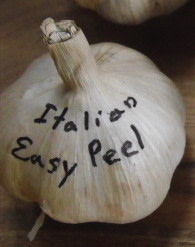Z3-8. Eco-grown in Maine.
Italian Easy Peel Hardneck Rocambole Garlic - Sustainably Grown
Italian Easy Peel Hardneck Rocambole Garlic - Sustainably Grown
Additional Information
Rocambole Garlic
Hardneck type produces 5–13 medium-large cloves with tan, brown or reddish skins, slightly loose and relatively easy-peeling. A shorter shelf life than Porcelains, maybe because the clove skins are looser, or because of a slight tendency to split cloves. Generally, stores well through February, and—if well cured and in optimal storage—can store months longer. Some claim Rocamboles have the finest, richest flavor.
Scapes form tight coils. Forms 8–25 bulbils, the size of peas; skins can be tight, but otherwise good cooking. More variation in cloves per pound than other classes.
Seed Garlic
The bulb size, the skin color, the flavor, and the size and number of cloves are partly determined by genetics, and partly by cultural practices, soil and weather.
Our standard for a seed garlic bulb is a minimum 2" diameter.
Hardneck Garlic
Hardneck garlic has a hard stalk in the center of the bulb, and (the vast majority of the time) only one ring of cloves. Plant grows an edible scape, a tall leafless stalk with a flower-like top. Not braidable, but can be tied in attractive bundles and hung.
Cut off the scape before it uncurls to get the best bulb size. Not easy on a commercial scale, but on a smaller scale it’s not much work, plus fresh tops are great in salads, stir-fries, pickles, pesto!
If you leave the tops on, the below-ground bulb will likely be smaller, but you’ll get a membrane full of bulbils. Depending on type, you can eat them, or plant them in autumn either for greens next spring or full-sized bulbs in two to four years.
Softneck garlic (which we’ve offered in the past) produces multiple rings of cloves and a soft braidable top. Hardnecks are closer to wild garlic, and have a greater range of character and more complex flavor than softneck. Hardnecks are much hardier, thus recommended for cold climates.



